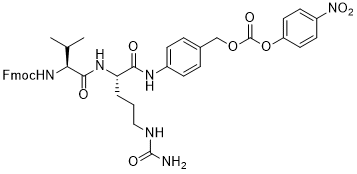Fmoc-Val-Cit-PAB-PNP is a linker for Antibody-Drug-Conjugation (ADC). The Val-Cit will specifically be cleaved by catepsin B. Because this enzyme is only present in the lysosome, the ADC payload will only be released in the cell. The azido group will react with DBCO, BCN or other alkyne groups through click chemistry. The hydrophilic PEG spacer increases solubility in aqueous media. References: Sano K, Nakajima T, Miyazaki K, Ohuchi Y, Ikegami T, Choyke PL, Kobayashi H. Short PEG-linkers improve the performance of targeted, activatable monoclonal antibody-indocyanine green optical imaging probes. Bioconjug Chem. 2013 May 15;24(5):811-6. doi: 10.1021/bc400050k. Epub 2013 May 3. PubMed PMID: 23600922; PubMed Central PMCID: PMC3674550.
Physicochemical Properties
| Molecular Formula | C40H42N6O10 |
| Molecular Weight | 766.795690059662 |
| Exact Mass | 766.3 |
| Elemental Analysis | C, 62.65; H, 5.52; N, 10.96; O, 20.86 |
| CAS # | 863971-53-3 |
| Related CAS # | 863971-53-3; |
| PubChem CID | 57641184 |
| Appearance | White to yellow solid powder |
| LogP | 5.6 |
| Hydrogen Bond Donor Count | 5 |
| Hydrogen Bond Acceptor Count | 10 |
| Rotatable Bond Count | 18 |
| Heavy Atom Count | 56 |
| Complexity | 1320 |
| Defined Atom Stereocenter Count | 2 |
| SMILES | CC(C)[C@@H](C(=O)N[C@@H](CCCNC(=O)N)C(=O)NC1=CC=C(C=C1)COC(=O)OC2=CC=C(C=C2)[N+](=O)[O-])NC(=O)OCC3C4=CC=CC=C4C5=CC=CC=C35 |
| InChi Key | USMYACISHVPTHK-SFCXHYMASA-N |
| InChi Code | InChI=1S/C40H42N6O10/c1-24(2)35(45-39(50)54-23-33-31-10-5-3-8-29(31)30-9-4-6-11-32(30)33)37(48)44-34(12-7-21-42-38(41)49)36(47)43-26-15-13-25(14-16-26)22-55-40(51)56-28-19-17-27(18-20-28)46(52)53/h3-6,8-11,13-20,24,33-35H,7,12,21-23H2,1-2H3,(H,43,47)(H,44,48)(H,45,50)(H3,41,42,49)/t34-,35?/m0/s1 |
| Chemical Name | (9H-fluoren-9-yl)methyl ((S)-3-methyl-1-(((S)-1-((4-((((4-nitrophenoxy)carbonyl)oxy)methyl)phenyl)amino)-1-oxo-5-ureidopentan-2-yl)amino)-1-oxobutan-2-yl)carbamate |
| HS Tariff Code | 2934.99.03.00 |
| Storage |
Powder-20°C 3 years 4°C 2 years In solvent -80°C 6 months -20°C 1 month Note: Please store this product in a sealed and protected environment (e.g. under nitrogen), avoid exposure to moisture. |
| Shipping Condition | Room temperature (This product is stable at ambient temperature for a few days during ordinary shipping and time spent in Customs) |
Biological Activity
| Targets |
Protease Cleavable Linker Cleavable Linker |
| ln Vitro |
A lysosome enzyme can break down the peptide sequence found in Fmoc-Val-Cit-PAB-PNP[1]. The peptide bond between Cit-PAB of dipeptide linkers containing Valine (Val)-citrulline (Cit) and p-aminobenzyl alcohol (PAB) is broken by cathepsin B in the lysosome. When a medication and PAB are covalently bound together by carbamate bonds, the drug can be liberated through hydrolysis following Cit-PAB peptide bond cleavage. Using this mechanism, antibody-drug conjugates (ADCs) have been developed[2]. |
| ln Vivo |
Prior to designing successful efficacy and safety studies in rodents during preclinical stages of ADC programs, mice must stabilize the Fmoc-Val-Cit-PAB-PNP linker[3]. The VC-PABC linker's stability in mouse plasma is largely determined by its conjugation site, and both in vitro and in vivo, the linker's stability and ADC's cytotoxic potency are positively correlated[3]. |
| References |
[1]. Cathepsin B-labile dipeptide linkers for lysosomal release of doxorubicin from internalizing immunoconjugates: model studies of enzymatic drug release and antigen-specific in vitro anticancer activity. Bioconjug Chem. 2002 Jul-Aug;13(4):855-69. [2]. A cell-penetrating peptidic GRP78 ligand for tumor cell-specific prodrug therapy. Bioorg Med Chem Lett. 2008 Mar 1;18(5):1632-6. [3]. Effect of attachment site on stability of cleavable antibody drug conjugates. Bioconjug Chem. 2015 Apr 15;26(4):650-9. [4]. Sano K, Nakajima T, Miyazaki K, Ohuchi Y, Ikegami T, Choyke PL, Kobayashi H. Short PEG-linkers improve the performance of targeted, activatable monoclonal antibody-indocyanine green optical imaging probes. Bioconjug Chem. 2013 May 15;24(5):811-6. doi: 10.1021/bc400050k. Epub 2013 May 3. PubMed PMID: 23600922; PubMed Central PMCID: PMC3674550. |
Solubility Data
| Solubility (In Vitro) | DMSO : ≥ 40 mg/mL (~52.16 mM) |
| Solubility (In Vivo) |
Solubility in Formulation 1: ≥ 5.25 mg/mL (6.85 mM) (saturation unknown) in 10% DMSO + 90% Corn Oil (add these co-solvents sequentially from left to right, and one by one), clear solution. For example, if 1 mL of working solution is to be prepared, you can add 100 μL of 52.5 mg/mL clear DMSO stock solution to 900 μL of corn oil and mix evenly. Solubility in Formulation 2: 10% DMSO+ 90% corn oil: ≥ 5.25 mg/mL (6.85 mM) (Please use freshly prepared in vivo formulations for optimal results.) |
| Preparing Stock Solutions | 1 mg | 5 mg | 10 mg | |
| 1 mM | 1.3041 mL | 6.5206 mL | 13.0412 mL | |
| 5 mM | 0.2608 mL | 1.3041 mL | 2.6082 mL | |
| 10 mM | 0.1304 mL | 0.6521 mL | 1.3041 mL |
